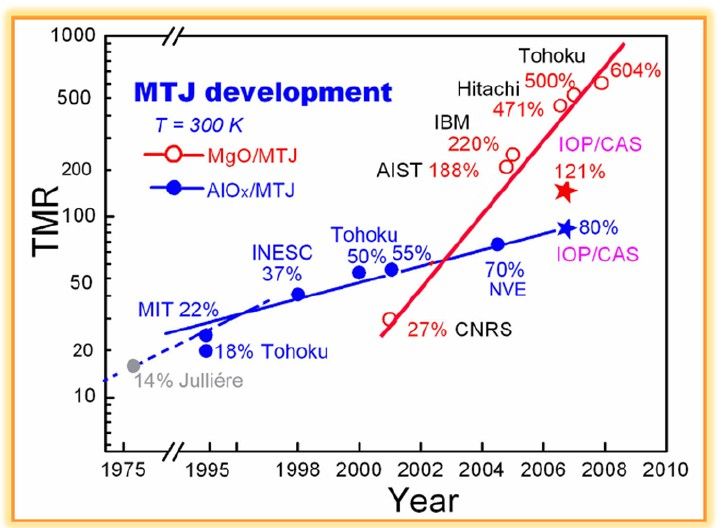In 1975, Julliere observed the TMR effect in the Magnetic Tunnel Junction (MTJ) sandwich structure (Co / Ge / Fe). The MTJ basic structure is (ferromagnetic / nonmagnetic insulating layer / ferromagnetic) or (FM / I / FM). However, this finding did not attract a lot of attention. Progress was gradual on the TMR effect over the next decade or so. The Spin-Dependent Tunneling (SDT) effect is the physical mechanism of the resistance change that one measures as TMR.
In 1988, the Brazilian scholar Baibich discovered the giant magnetoresistance (GMR) effect in Fe / Cr multilayers. He was working in the Department of Physics at the University of Paris, France, in the research group led by Professor Fert. Discoveries of the GMR and TMR effects led to a new branch in condensed matter physics – spintronics. Over the past 20 years, the GMR Effect has developed very rapidly, and both basic research and applied research are pursued. The GMR Effect is a basic research result that was rapidly transformed into commercial applications.
Along with further research into the GMR effect, the TMR effect has begun to attract attention. Although the metal multilayer film can produce a high GMR value, the strong antiferromagnetic coupling effect leads to a high saturation field, so the magnetic field sensitivity is small (compared to TMR), which limits the practical applications the GMR effect.
In MTJs, the two ferromagnetic layers have very little interlayer coupling. So, only a small external magnetic field is needed to reverse the magnetization direction of a ferromagnetic layer in an MTJ. The tunneling resistance changes a great deal in the MTJ, in a smaller field, so the MTJ has a much higher magnetic field sensitivity than a typical GMR film.
Meanwhile, the MTJ structure itself can have very high, or very low resistivity; low energy consumption, and stable magnetic performance. Therefore, MTJ elements used as read heads, sensors, or in Magnetic Random Access Memory (MRAM), have unique advantages. Their future technical prospects are also very good, so TMR has attracted the attention of research teams around the world.

Figure 1: Tunneling Magnetoresistance research and development timeline


